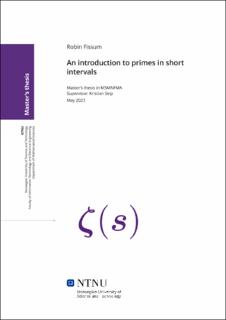| dc.contributor.advisor | Seip, Kristian | |
| dc.contributor.author | Fissum, Robin | |
| dc.date.accessioned | 2023-07-21T17:20:37Z | |
| dc.date.available | 2023-07-21T17:20:37Z | |
| dc.date.issued | 2023 | |
| dc.identifier | no.ntnu:inspera:142439538:29703762 | |
| dc.identifier.uri | https://hdl.handle.net/11250/3080843 | |
| dc.description.abstract | I denne oppgaven gir vi en introduksjon til studiet av primtall i korte intervaller: Primtallsatsen er ekvivalent med utsagnet om at antall primtall i intervallet (x, x + h] er asymptotisk med h / log x når h = x, og vi undersøker om ikke det samme kan sies for h < x.
Vi begynner med å diskuter Riemanns zetafunksjon, og hvordan Riemannhypotesen, Lindelöf-hypotesen og tetthetshypotesen er relatert til dens nullpunkter. Deretter utleder vi den eksplisitte formelen for den andre Chebyshevfunksjonen, og relaterer denne til antall primtall i et intervall. Sammen med noen moderate antagelser om nullpunktene hos zeta, beviser vi Hoheisels teorem: utsagnet om at vi kan tillate oss h = o(x). Videre antar vi Riemannhypotesen, og viser at en asymptotisk formel da holder når sqrt(x) log x = o(h); vi kommer også inn på Cramérs teorem for primtallsgap. Mot slutten viser vi hvordan Selbergs kvadratgjennomsnittsmetode gir innsikt i h < sqrt(x), samt noen av de assosierte utfordringene og formodningene rundt intervall av denne lengden. | |
| dc.description.abstract | In this thesis, we give an introduction to the study of primes in short intervals: the prime number theorem is equivalent to the statement that the number of primes in the interval (x, x + h] is asymptotic to h / log x when h = x, and we investigate if not the same can be said for h < x.
We begin by discussing the Riemann zeta function, and how the Riemann hypothesis, Lindelöf hypothesis and the density hypothesis are related to its zeros. Afterwards, we derive the explicit formula for the second Chebyshev function, and relate this to the number of primes in an interval. Together with some moderate assumptions on the zeros of zeta, we prove Hoheisel's theorem: the assertion that h = o(x) is permissible. Next, the Riemann hypothesis is assumed, and we show that an asymptotic formula then holds when sqrt(x) log x = o(h); we also give an account of Cramér's theorem for prime gaps. Towards the end, we show how Selberg's mean-square method gives insight into the case h < sqrt(x), and some of the associated obstacles and heuristics for intervals of this length. | |
| dc.language | eng | |
| dc.publisher | NTNU | |
| dc.title | An introduction to primes in short intervals | |
| dc.type | Master thesis | |
